As the 2018-19 NHL regular season winds down, it’s time to begin looking to the offseason. For the Nashville Predators, the summer of 2019 is unlikely to be eventful on the roster front as general manager David Poile only has a few pending free agents to make decisions about this offseason.
This article looks at the Predators’ 2019 free agents. Some are unrestricted free agents (UFAs) and are able to sign with any team on July 1. Others are restricted free agents (RFAs) and their rights are held by the Predators, unless released. I will look at all of the team’s free agents in both categories and make an assessment about what Poile should do with each player. First up, the UFAs.
*All salary information from THW’s Nashville Predators Salary Cap Page
Unrestricted Free Agents
Brian Boyle
Veteran center Brian Boyle was one of the Predators’ acquisitions leading up to the 2019 Trade Deadline. In 47 games with the New Jersey Devils before the trade, the 34-year-old center had 13 goals and 19 points, a sub-45 percent Corsi and won 50.2 percent of faceoffs. The Predators acquired him to play a bottom-six role and be a net-front presence on the power play. Since the trade, he has surpassed expectations.
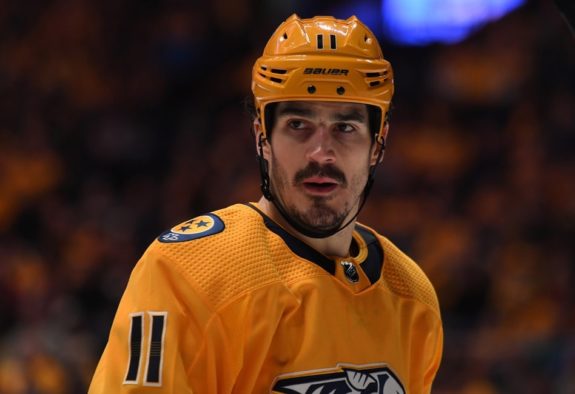
In 22 games with Nashville, he has five goals, including one on the power play, and is winning 54.4 percent of faceoffs. He also possesses a 48.5 percent Corsi since the trade. His goals since joining the Predators have also been timely and impactful, with four of them occurring in a win and were either a game’s opening or a tie-breaking goal.
Boyle is finishing up the second year of a two-year, $5.1 million contract the Devils signed him to on July 1, 2017. Given his age, he will likely be looking for another two or three-year deal that will possibly close out his career. It would be a contract similar to the last three he signed, all with cap hits between $1.7 and $2.55 million. A team likely won’t have a problem giving him a short-term contract with a cap hit around $2.25 million. The biggest concern with Boyle as he ages will be his size. At 6-foot-6 and 245 pounds, he already has difficulty keeping up with the pace of today’s NHL, and as the league gets faster, he’ll likely have more difficulty.
Should the Predators Re-Sign Him?
Despite his size and footspeed concerns, I think Boyle still provides enough value that signing him isn’t outlandish. He’s still a productive fourth-line forward who kills penalties and is a nightmare on the power play. In a limited role at five-on-five, he can be a valuable contributor, even for the Predators. However, I’m not certain there will be room for him.
Nick Bonino, Frédérick Gaudreau, Austin Watson and Rem Pitlick are potential bottom-six forwards who are signed through next season and that doesn’t include Poile re-signing any of the other free agents or calling up any players in the minors. The Predators will also be tight on cap space next season with just over $5.9 million in space after the projected $83 million salary cap for 2019-20.
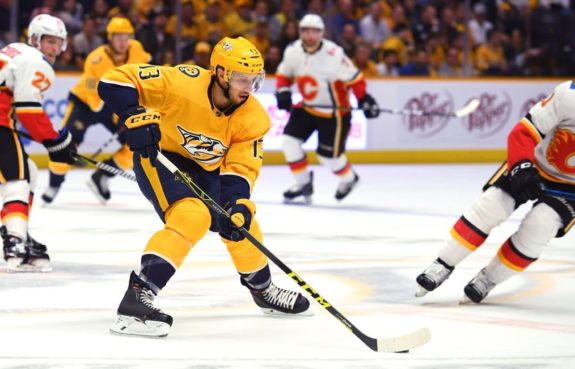
Considering the need to re-sign other free agents and potentially add players in free agency, I don’t think there will be room for Boyle next season. It’s a shame, considering he’s a great locker room guy and a positive-impact player on the ice, but I don’t see a scenario in which he and the Predators can come to an agreement that’s beneficial to both.
Wayne Simmonds
Another of Poile’s deadline additions, I think most people saw Wayne Simmonds as a prototypical playoff rental. In 62 games with the Philadelphia Flyers, he had 16 goals and 27 points. Five of his goals came on the man advantage and he shot 11.8 percent. Although Simmonds was an underrated two-way player for much of his career, he has regressed without the puck in recent seasons, including a 47.1 percent Corsi this season before the trade. It was because of this regression that Poile only had to part with Ryan Hartman and a conditional fourth-round pick for Simmonds.
Although Simmonds was mostly acquired to provide help on the power play, he hasn’t lived up to expectations with just one goal and one assist and no points on the man advantage, in 13 games with Nashville. His Corsi has actually regressed to 45.2 percent and he’s only playing 13:25 per game. Perhaps there’s room for rebound considering he’s shooting 5.6 percent since the trade.
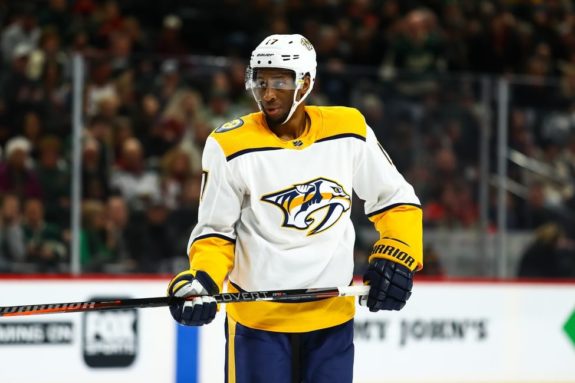
Simmonds is in the last year of a six-year deal with a $3.975 million cap hit. Given that he averaged 28.8 goals and 54 points over the contract’s first four years, he was one of the league’s most valuable players and was in line for a big payday on his next contract. But after what he produced in 2017-18 and has produced this season, that payday may have disappeared, especially considering he’ll turn 31 before next season.
Should the Predators Re-Sign Him?
I’ve been a fan of Simmonds for a long time and was pulling for the Predators to acquire him at this season’s trade deadline. I remain a fan of his game: a tough player who is ferocious on the forecheck, unafraid to go to the front of the net or drop the gloves, while at the same time skilled enough to capitalize on rebounds or get tips on pucks. That being said, Simmonds needs to remain a playoff rental.
He doesn’t bring much at five-on-five anymore and he alone won’t fix the Predators’ abysmal power play. Then there’s the fact that he’ll price himself out of the team’s budget. Even with a down season, he should get a cap hit of at least $4.5 million on a short-term deal. And even if he took a lower cap hit with more term, that doesn’t bode well for a player who is already on the wrong side of 30 with a history of injuries. But even if salary and term weren’t concerns, there isn’t room for him moving forward.
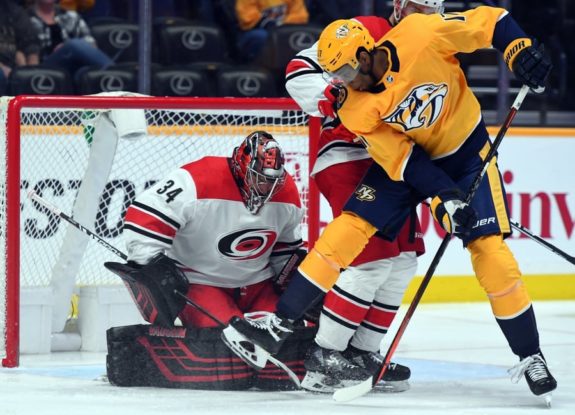
At his best, Simmonds should be a second-line winger. However, with the way he has been playing, he’s more deserving of third-line minutes, and the Predators already have enough players to serve that role. Plus he’ll cost too much to average 13 minutes per game. Poile should thank Simmonds for his services, be glad he didn’t overpay and steer clear of him in free agency.
Cody McLeod
The remaining pending UFA that Poile acquired this season is Cody McLeod, traded for on the same day the Predators landed Boyle. At the time, I didn’t understand the move, and still don’t, even if it only meant giving up a 2020 seventh-round pick. Many thought the trade occurred in response to Austin Watson’s suspension and that the addition of McLeod would add some grit, or in the words of Brian Burke, “truculence” to the lineup. If that was the reasoning for acquiring him, it wasn’t a good use of resources, and it shouldn’t be surprising that he hasn’t done anything since the trade.
In 31 games with the New York Rangers before the trade on Feb. 6, McLeod had one goal and was a minus-10 while averaging 6:49 per game. He also had a 38.7 percent Corsi and had racked up six major penalties and one misconduct. Since the trade, he’s been a healthy scratch more often than not, appearing in only seven of the team’s 23 games. He has no points, is a minus-3, averages 5:02 per game and has a 48.5 percent Corsi with one major penalty. That kind of player can be found almost anywhere.
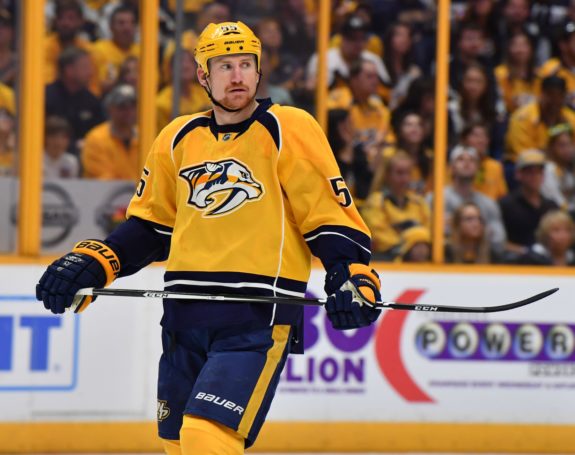
Thankfully, McLeod is a UFA this offseason when the one-year deal he signed with the Rangers last summer expires. His $750,000 cap hit is cheap, but you could argue he hasn’t even been worth that.
Should the Predators Re-Sign Him?
This question really doesn’t need to be asked, but I’ll answer it anyway. No, the Predators should not retain him. Enforcers have nearly been eradicated from the league, and if a player can’t skate or doesn’t have scoring potential, it’s hard for him to stay in the league. Therefore there’s no reason to even consider re-signing McLeod.
Zac Rinaldo
Poile signed Zac Rinaldo to a one-year, $650,000 contract last summer and is another transaction that made little sense at the time. Entering this season, he had 14 goals and 34 points in 328 career games and has never scored double-digit points in a season. And he won’t come close to reaching double-digits this season either. In 23 games, he has one goal and three points while averaging 7:07 per game. He also has a 44.2 percent Corsi and two fighting majors. His season ended when he was placed on injured reserve on Jan. 18 with a shoulder injury.
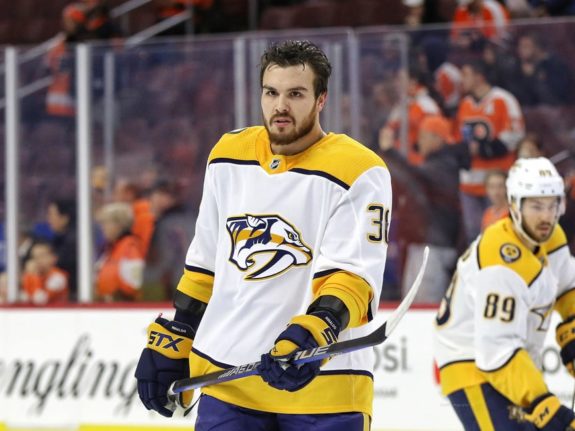
Should the Predators Re-Sign Him?
Like McLeod, Rinaldo is a dime-a-dozen player. Yes, he’s cheap, but he brings almost nothing offensively and takes up a lineup spot that someone with more talent could have. Even if Poile feels the need to keep some size and toughness in the lineup, Rinaldo doesn’t have to be that player. The Predators should not re-sign him.
Restricted Free Agents
Colton Sissons
Now onto the RFAs, beginning with Colton Sissons, the Predators’ second-round pick (50th overall) in the 2012 Draft. They selected him from the Western Hockey League’s Kelowna Rockets where he had 26 goals and 41 points in 58 games in his draft season. He followed that up with 28 goals and 67 points in 61 games in 2012-13. He reached the NHL the following season and became an NHL regular in 2016-17. So far in his NHL career, he has played in 261 regular-season games with 35 goals and 75 points while winning 53.4 percent of faceoffs. He has also appeared in 45 playoff games with nine goals and 19 points.
Related: Most Valuable Predator: Colton Sissons
He’s had a breakout campaign in 2018-19 with 71 games played, 13 goals and 28 points, the latter two being career highs. Twenty-five of his points have occurred at even strength, he’s a plus-20 and has a plus-11 turnover differential while averaging 16:01 per game with a 50.3 percent Corsi. He has played on every line this season, largely playing in the middle six, but did center the top line during Ryan Johansen’s two-game suspension. Simply put, Sissons is incredibly valuable and impactful to the Predators.
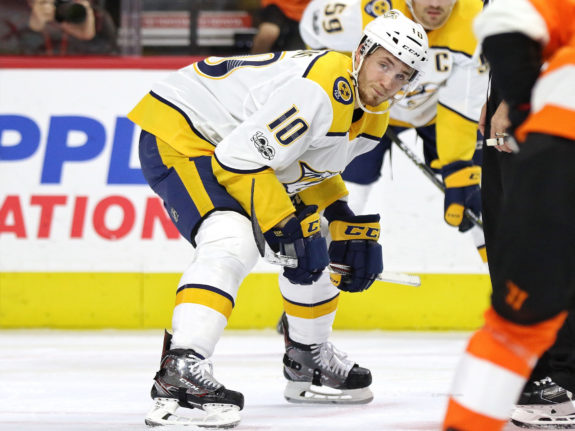
After this season, the three-year bridge deal he signed in Feb. 2016will expire. His $625,000 cap hit has been a gross underpay considering his goal and point totals have improved every season in the NHL and that he plays in every situation. Now 25 years old, Sissons is entering what is traditionally a player’s prime years and will be due a raise.
Should the Predators Re-Sign Him?
For Sissons, this question should be adjusted to ‘What Contract Should the Predators Sign Him To?’ There is no way Poile will let Sissons go to free agency. Because he already signed a bridge deal, I doubt Sissons will have any appetite for signing another one. And, to be honest, Poile and the Predators shouldn’t either if they value him long-term. So what should his next contract look like? Fellow Predator Calle Järnkrok is a solid comparison.
In July 2016, the Predators signed Järnkrok to his current six-year, $12 million contract. He signed that deal after posting 16 goals and 30 points in 81 games. All were career highs at the time. Since signing the deal, he’s posted at least 15 goals and 31 points in two of three seasons. That contract has been a value deal for the Predators given that he was coming off his age-24 season at the time. I’m sure Poile would love to ink Sissons to a comparable deal, but I don’t think Sissons will have interest in undervaluing himself like that.
Instead, I think the average annual value has to be more in the $2.5 to $3 million range and maybe a three or four-year deal. Sissons could surpass Järnkrok’s point total from the season before he signed his deal, plus the salary cap has increased since then.
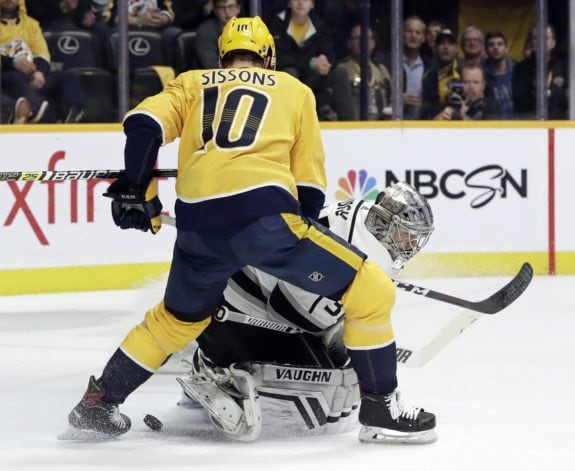
Even a cap hit in the $2.5 to $3 million range is somewhat of an underpay, but keep in mind that Tennessee has no state income tax, meaning his take-home pay is higher than it would be in most other markets. Regardless of what his new deal looks like, getting one done is of the highest importance this offseason. Sissons has proven himself to be a vital part of the team, and needs to continue to be moving forward.
Rocco Grimaldi
When Poile signed Rocco Grimaldi to a one-year deal last summer, I doubt many in the hockey world thought much of it. I mean it was a two-way contract that pays him $650,000 at the NHL level and $175,000 in the AHL. He had 37 NHL games, five goals and 10 points with two teams across four seasons to his name. It was pretty obvious he was expected to be a regular in the AHL, where he has been incredibly successful with 80 goals and 172 points in 247 games. So when the Predators called him up on Nov. 25 for the second time this season, he wasn’t expected to stick, but he’s proven everyone wrong.
In 53 games this season, he has five goals and 13 points, all which surpass his career totals entering 2018-19. While the numbers are surprising, perhaps they shouldn’t be. The Florida Panthers drafted Grimaldi 33rd overall in the 2011 Draft after a productive two-season stint with the U.S. National Team Development Program.
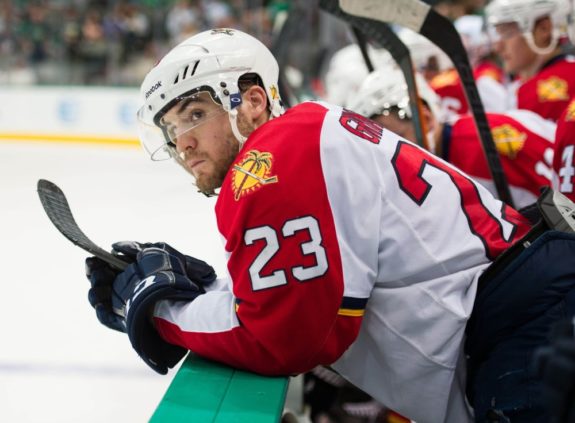
He followed that up with three quality seasons with the University of North Dakota before turning pro in 2014-15. The Panthers gave him 27 NHL games over two seasons before trading him to the Colorado Avalanche in June 2016. The Avalanche didn’t play him much either, only 10 games in two seasons. A free agent in 2018, the Predators signed him.
It appears that all Grimaldi needed was a chance, and he’s capitalized on it. He may be undersized at 5-foot-6, but he’s proven himself valuable in all three zones while playing bottom-six minutes. He’s strong on the forecheck while being defensively responsible and has a plus-12 turnover differential and a 57.5 percent Corsi. With his one-year deal expiring this summer, he should be in line for his first multi-year contract since his entry-level contract concluded.
Should the Predators Re-Sign Him?
A short, two-to-three-year deal in the $1 million range would make a lot of sense. Grimaldi has middle-six upside but there’s an absence of room on the Predators’ NHL roster to fill that role. Not to mention prospects Pitlick and Eeli Tolvanen, who will be pushing for playing time next season. But in a fourth-line role, Grimaldi is an excellent option to call upon for offense and should be paid as such.
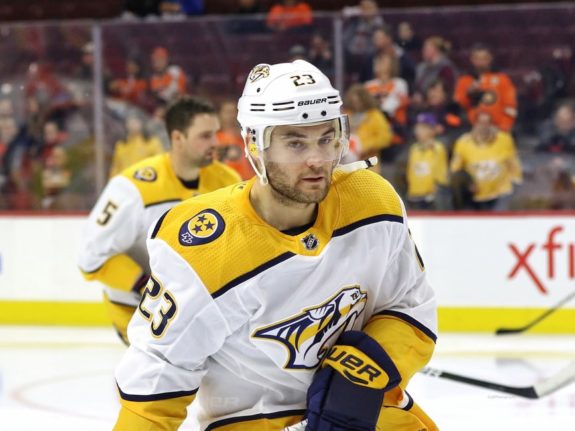
A Light Summer
The summer of 2019 figures to be a quiet offseason for the Predators from a free agent standpoint. With only four UFAs and two RFAs, the 2019-20 roster is likely to be similar to the 2018-19 edition. That’s pretty typical of teams that are perennial contenders. However, that doesn’t mean Poile won’t be active on the trade market, but I’ll cover that in a different article.
*All stats come from Hockey-Reference, Elite Prospects and Natural Stat Trick